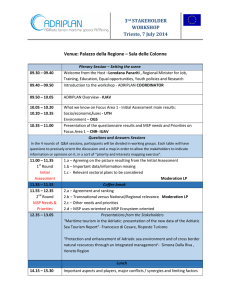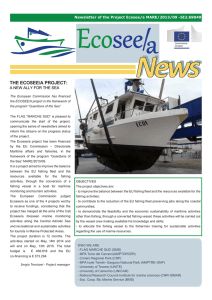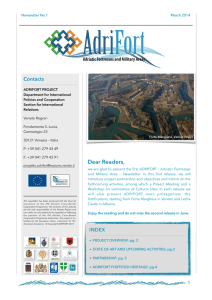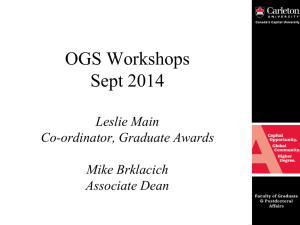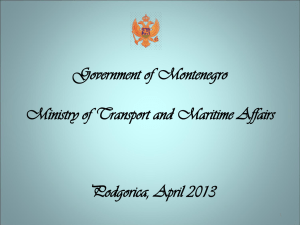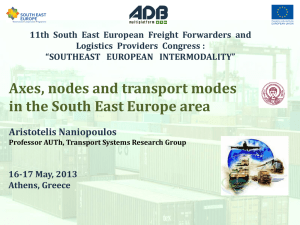Diapositiva 1 - Protezione Civile
advertisement
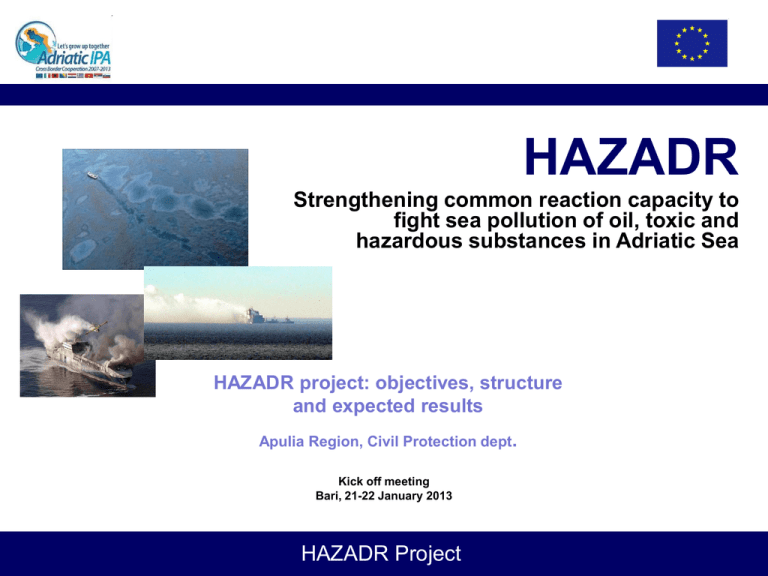
HAZADR Strengthening common reaction capacity to fight sea pollution of oil, toxic and hazardous substances in Adriatic Sea HAZADR project: objectives, structure and expected results Apulia Region, Civil Protection dept. Kick off meeting Bari, 21-22 January 2013 HAZADR Project BACKGROUND, OBJECTIVES AND RESULTS PROJECT STRUCTURE PROJECT GOVERNANCE HAZADR Project project background The Adriatic is one of the most sensitive sea in the world due to its important oil transport route to the North Adriatic ports of Trieste, Venice and Omišalj. Additionally it hosts the 30% of the overall international maritime traffic. Pollution by oil, hazardous & noxious substances may have disastrous consequences for the delicate environment and important sea based economic activities if adequate measures are not taken to prevent and enhance general safety. Over the past 15 years, a total of 174 accidents has been recorded on the Adriatic: this warns that a joint cooperation at all levels is necessary for a prompt and efficient response. HAZADR Project the challenges • Adriatic area has been affected by numerous maritime incidents: for example, the 2008 incident with the Turkish ship «UND ADRIYATIK» revealed the lack of organization and ability of regions and counties on both sides of the Adriatic to deal with such incidents at sea. • In some regions, inadequately trained and nonqualified personnel and extremely poor cross-border coordination among bodies involved in the implementation of contingency plans. • Lack of appropriate equipment by regions and counties in the Adriatic area. • Need of training and research centers in the Adriatic area to homogenize diverging response procedures and measures in case of sea pollution HAZADR Project general objective the establishment of a cross - border network for the prevention of risks and the management of emergencies, in order to reduce the risk of pollution and contamination of the Adriatic sea and to strengthen a common reaction capacity of the communities belonging to the Adriatic Region against environmental and technological hazards due to collisions, shipwrecking and spillage of oil and toxic material into the sea that are able to affect the marine environment and economic activities of the Adriatic coastal regions and counties. HAZADR Project Project Specific Objectives (1) • Upgrade the knowledge framework on the estimated environmental and socio-economic risks in the most vulnerable Adriatic areas due to natural and humaninduced factors. • Support decision-making process in preventing, reacting and overcoming emergencies (also for the benefit of countries not directly involved in the project but treated by oil spillage contamination in case of shipwrecks or collisions). • Harmonize, improve and shorten deployment time of the cross-border reaction capacity in the toxic and hazardous substances spill by enhancing the coordination / reaction capacity in the Adriatic EUROREGION. HAZADR Project Project Specific Objectives (2) • set up a common database on the state of readiness and spatial distribution of pollution preventing equipment along the Adriatic coasts as well as the improvement of the operational instruments and oil spill mitigation programs to cope with the environmental and technological hazards. • Improve, through 2 cross-border joint exercises in Adriatic and the establishment of an Adriatic Training and Research Centre, the cross-border coordination reaction capacity. • Improve an early warning system through a joint radar monitoring program based on a set of radar systems and VHF devices, leading to an advanced capacity of the entrusted Euroregion actors to identify potential sources of risks menacing ecosystems. HAZADR Project an outstanding partnership PROJECT DURATION:01/10/2012 - 31/03/2015 30 MONTHS 1 Ministry, 7 Regions & Counties, 5 Research bodies 5 IPA Adriatic countries 13 partners and 11 costal areas concerned HAZADR Project project partners 1. Apulia Region - Department of Civil Protection – IT - LP Slovenia 2. County of Primorje and Gorski Kotar – HR Croatia 3. Zadar County – HR 4. Split-Dalmatia County – HR 5. Region of Istria – HR 6. Emilia Romagna Region – IT 7. Marche Region – IT Bosnia and Herzegovina Serbia Montenegro Italy Adriatic Sea 8. National Research Council, Water Research Inst. CNR – IT 9. National Institute of Oceanography and Experimental Geophysics – OGS – IT 10. Institute of Oceanography and Fisheries – HR Albania 11. Ministry of Public Works and Transport – ALB 12. National Institute of Biology – Marine Biology Station – SI 13. Institute of Marine Biology, University of Montenegro – MNE Eligible Program m e Area Territorial derogation Phasing Out HAZADR Project Greece added value of cross boarder cooperation • Reduced deployment time of response teams (up to 70% of actual performance) to the incident sites. • Positive impact on reducing external costs to the economy arising from environment protection (e.g. compensation for pollution damages). • Create prerequisites for economic growth and sustainable development of coastal regions and counties. • The establishment of a joint Training and Research Centre for combating marine pollution by oil, hazardous and noxious substances for the whole Adriatic Region. • Elaboration of common guidelines for the whole Adriatic area which will serve as a basis for the drafting of contingency plans in regions where such plans have not yet been adopted, as well as for the updating of existing contingency plans. HAZADR Project sustainability of the project The Research and Training Center Deployment time of response teams Cross-border disaster simulations The continuation of activities related to enhancing the preparedness and response capacities at sea, both at cross-border and regional and county levels are assured by the Research and Training Centre that will continue its operation even after the finalization of the project. Reduced deployment time of response teams (up to 70% of actual performance) to the incident sites will assure the homogeneity in the application of the own contingency plans and the sustainability of the joint rescue-procedure in Adriatic over the years. the acquired knowledge and experiences gained through cross-border exercises shall be the basis for a concrete joint reaction capacity, guaranteeing long last effects of the project so as to maintain the high level of preparedness for the future emergency situations at sea. HAZADR Project BACKGROUND, OBJECTIVES AND RESULTS PROJECT STRUCTURE PROJECT GOVERNANCE HAZADR Project HAZADR - WORK PACKAGES WP 1 CROSS-BORDER PROJECT MANAGEMENT AND COORDINATION 1 OCTOBER 2012 WP 2 COMMUNICATION & DISSEMINATION WP 3 HARMONIZING NATIONAL REGIONAL AND COUNTY CONTINGENCY PLANS IN ADRIATIC WP 4 IMPROVING THE LEVEL OF EQUIPMENT AND C.B. RESPONSE PREPAREDNESS IN CASE OF ACCIDENTAL MARINE POLLUTION Duration 30 months HAZADR Project WP 5 ESTABLISHMENT OF A TRAINING AND RESEARCH CENTRE TO COMBAT MARINE POLLUTION BY OIL, NOXIOUS AND HAZARDOUS SUBSTANCES 31 MARCH 2015 WP1 – CROSS-BORDER PROJECT MANAGEMENT AND COORDINATION • Leader: Apulia Region • Duration: 1.10.2012 – 31.03.2015 (30 months) Project coordination is assured by a Steering Committee led by the LP, and composed by 1 representative from each PP, to supervises the whole of processes, evaluate the technical project performance / level of achievements and takes strategic decisions. Financial management: each partner is committed to look after own administrative and financial procedures. The LP assures the whole project technical-administrative and financial management towards the Programme Authorities by keeping all advances monitored at every project phase. 1 Quality Management Board, composed by the WP leaders, is establish to boost the technical implementation of the project phases (in accordance with the SC) One Joint Management Service appointed by LP on behalf of all PPs to ensure the coordination of all activities at project level by supporting all PPs in the daily management (strategic programming; technical-financial project monitoring; help-desk; support to the international events & communication activities) 1.1 Project Steering Committee 1.2 Project Technical Secretariat 1.3 Financial and administrative management HAZADR Project 1 CROSS-BORDER PROJECT MANAGEMENT AND COORDINATION 1.1 Steering Committee meetings October 2012 – March 2015 Duration Description Establishment of the project Steering Committee (SC), chaired by the lead partner and composed by 1 representatives of each PP. 1 Quality Management Board Established The SC supervises the whole of the processes and gives strategic addresses to the implementation, evaluate the project performance and the level of achievements. 6 meetings scheduled 1. Bari - IT (January 2013) 2. Rijeka – HR (June 2013? To be decided) 3. Piran – SI 4. Tirana – AL 5. Zadar – HR 6. Pula – HR LB B1 B2 B3 B4 B5 B6 B7 B8 B9 B10 B11 B12 Apul PGZ Zadar Split Istarsk Emilia Marche CNR OGS IOF Split MPWT Albania NIB Piran IMB Monten 1 1 1 1 1 1 1 1 1 1 1 outputs Meetings SC Meetings QMB Project SC established 1 HAZADR Project 1 CROSS-BORDER PROJECT MANAGEMENT AND COORDINATION 1.2 Project Technical Secretariat Duration Description October 2012 – March 2015 The project Technical Secretariat (PTS), appointed and paid by Lead Partner on behalf of all Partners, supports the LB and all project actors in the day-by-day management (strategic programming, coordination of the activities; technical and financial project monitoring; help-desk; support to the organization and participation in the international events, communication activities’ supervision). LB B1 B2 B3 B4 B5 B6 B7 B8 B9 B10 B11 B12 Apul PGZ Zadar Split Istarsk Emilia Marche CNR OGS IOF Split MPWT Albania NIB Piran IMB Monten outputs PTS appointed to support all partners in the project man. 1 HAZADR Project 1 CROSS-BORDER PROJECT MANAGEMENT AND COORDINATION 1.3 Financial and Administrative management Duration Description October 2012 – March 2015 Overall economic-financial management of HAZADR project. Each partner is committed to look after the own technical, administrative and financial management and the preparation of the own progress reports on the MIS system, while the LB is responsible for the overall reporting to the IPA programme and supervises on the reimbursement procedures. 1 project manager + 1 financial manager appointed by every partner. LP has the responsibility to coordinate the management at project level according to the rules stated in the Subsidy Contract and Partnership Agreement. LB B1 B2 B3 B4 B5 B6 B7 B8 B9 B10 B11 B12 Apul PGZ Zadar Split Istarsk Emilia Marche CNR OGS IOF Split MPWT Albania NIB Piran IMB Monten Project man. Financial man. 1+1 1+1 1+1 1+1 1+1 1+1 1+1 1+1 1+1 1+1 1+1 1+1 1+1 ProgressReport per year 2 2 2 2 2 2 2 2 2 2 2 2 2 Global Report + Final Report 6 outputs HAZADR Project HAZADR - WORK PACKAGES WP 1 CROSS-BORDER PROJECT MANAGEMENT AND COORDINATION 1 OCTOBER 2012 WP 2 COMMUNICATION & DISSEMINATION WP 3 HARMONIZING NATIONAL REGIONAL AND COUNTY CONTINGENCY PLANS IN ADRIATIC WP 4 IMPROVING THE LEVEL OF EQUIPMENT AND C.B. RESPONSE PREPAREDNESS IN CASE OF ACCIDENTAL MARINE POLLUTION Duration 30 months HAZADR Project WP 5 ESTABLISHMENT OF A TRAINING AND RESEARCH CENTRE TO COMBAT MARINE POLLUTION BY OIL, NOXIOUS AND HAZARDOUS SUBSTANCES 31 MARCH 2015 WP2 – COMMUNICATION AND DISSEMINATION • Leader: Zadar County • Duration: 1.10.2012 – 31.03.2015 (30 months) Effective communication and knowledge management within and outside the partnership is assured through the usage of several dissemination channels and potentials for the transferability of outputs, results and best practices towards a broad range of relevant target groups (like policymakers, stakeholders, professionals) concerned by coastal defence, environmental maritime issues and transport safety. Project communication strategy – coordinated by B2 and based on a Mainstreaming Action Plan and one Capitalization Action Plan - is implemented through a multi-tool Information Package. In each project area, one communication manager takes care of the communication processes to address the message to the identified local target groups. 1 international final conference is scheduled in Rijeka to promote and link HAZADR deliverables to most relevant DG Units, EU Mechanism of Civil Protection, IMO and Maritime Safety agency. The realization of one final technical publication in English to deliver the message outside the project areas is planned. Relevant information of the project, which shall have a clear visual identity, shall be disseminated according to the Communication and Visibility Plan, using both direct and indirect communication methods, in line with the guidelines for communication set by the IPA Adriatic programme 2.1 Project communication strategy and MEDIA relationship management 2.2 Multi-channels communication activities 2.3 Final publication and video documentary 2.4 Final conference, targeted workshops and visits HAZADR Project 2 COMMUNICATION AND DISSEMINATION 2.1 Project communication strategy and MEDIA relationship management Duration Description October 2012 – March 2015 Elaboration of one project communication strategy composed by (a) 1 Mainstreaming Action Plan - MAP (to drive project dissemination towards target groups, with special regard to Adriatic administrations not directly involved in the project and coastal communities exposed to risk) (b) 1 Capitalization Action Plan CAP (to streamline results and addressing at least 1 follow-up project initiatives, to be presented at the final conference). One communication manager per area to appointed, under the coordination of B2 This activity includes also the MEDIA relationship management, concerning the draft of articles and press releases (4 articles/press releases to be issued by the LB and B2; 2 articles/press releases to be issued by the all other beneficiaries. LB B1 B2 B3 B4 B5 B6 B7 B8 B9 B10 B11 B12 Apul PGZ Zadar Split Istarsk Emilia Marche CNR OGS IOF Split MPWT Albania NIB Piran IMB Monten outputs Project Comm. Strategy (MAP + CAP) 1 Local Comm. manager 1 1 1 1 1 1 1 1 1 1 1 1 1 Articles / press releases 4 2 4 2 2 2 2 2 2 2 2 2 2 HAZADR Project 2 COMMUNICATION AND DISSEMINATION 2.2 Multi-channels communication activities Duration Description October 2012 – March 2015 Development of a multi-channels communication activities, that includes (a) 1 project website through which it will be possible to access to all management and information tools realized within the project. It contains a unique web platform concerning risk management information, including Adriatic GIS maps of vulnerable areas (2) project brochure in EN and all partners’ languages, leaflets and paperboards to be produced to inform inhabitants and sailors living along the seashore about the best behaviours in case of environmental and / or technological hazards (3) 4 issues of the international e-newsletter LB B1 B2 B3 B4 B5 B6 B7 B8 B9 B10 B11 B12 Apul PGZ Zadar Split Istarsk Emilia Marche CNR OGS IOF Split MPWT Albania NIB Piran IMB Monten 1 1 1 1 1 1 (AL) 1 (Slov) 1 (MNE) outputs Project website Link on PPs’’ local website 1 1 Project brochure in EN 1 1 1 1 1 1 1 Project brochure in national lang. issues of the inter.newsletter 1 1 (HR) 4 1 (IT) HAZADR Project 2 COMMUNICATION AND DISSEMINATION 2.3 Final publication and video documentary Duration Description December 2014 – March 2015 Realization of one final publication of the project in English, that describes the achievements and results, and preparation of 1 video documentary about the project (including exercises) to be broadcasted on the TV and web, which is considered one of the smartest and most effective solution to reach the mass of stakeholders all over the Adriatic area LB B1 B2 B3 B4 B5 B6 B7 B8 B9 B10 B11 B12 Apul PGZ Zadar Split Istarsk Emilia Marche CNR OGS IOF Split MPWT Albania NIB Piran IMB Monten x x x x x outputs International final publication 1 Video documentary Broadcast on TV / internet 1 x x x x x x x HAZADR Project x 2 COMMUNICATION AND DISSEMINATION 2.4 Final conference, targeted workshops and visits Duration Description October 2012 – March 2015 Organization of one final conference in Rijeka to present the results of HAZADR to the wide public and stakeholders and to national and regional administration not directly involved in the project but crucial for the follow-up of EUROREGION joint monitoring and hazard-reaction system. DG Units, EU Mechanism of Civil Protection, IMO and Maritime Safety agency will be invited to take part in the event. 2 local workshops per concerned region to promote – among the main stakeholders - the project results and 1 visit to the EU Civil Protection Mechanism at the EU Commission to promote the common reaction capacity model developed in Adriatic LB B1 B2 B3 B4 B5 B6 B7 B8 B9 B10 B11 B12 Apul PGZ Zadar Split Istarsk Emilia Marche CNR OGS IOF Split MPWT Albania NIB Piran IMB Monten 2 2 2 2 2 2 2 2 outputs International conference 1 Local workshops 2 Visit at the EU Civili Protection Mechanism in Brussels to promoteHAZADR approach 1 2 HAZADR Project HAZADR - WORK PACKAGES WP 1 CROSS-BORDER PROJECT MANAGEMENT AND COORDINATION 1 OCTOBER 2012 WP 2 COMMUNICATION & DISSEMINATION WP 3 HARMONIZING NATIONAL REGIONAL AND COUNTY CONTINGENCY PLANS IN ADRIATIC WP 4 IMPROVING THE LEVEL OF EQUIPMENT AND C.B. RESPONSE PREPAREDNESS IN CASE OF ACCIDENTAL MARINE POLLUTION Duration 30 months HAZADR Project WP 5 ESTABLISHMENT OF A TRAINING AND RESEARCH CENTRE TO COMBAT MARINE POLLUTION BY OIL, NOXIOUS AND HAZARDOUS SUBSTANCES 31 MARCH 2015 WP3 – Harmonizing national, regional & county contingency plans in Adriatic • Leader: CNR • Duration: 1.10.2012 – 31.01.2015 (28 months) The purpose of WP3 is to harmonize response procedures and measures in national and regional contingency plans of individual Adriatic states which is due to diverging regulations that reduce the cross-border coordination capacity in the event of spills. This goal shall be achieved by a three-level analysis (1) regulatory and legal analysis that encompass general and specific regulations (2) national and regional contingency plans to identify points in common, bottlenecks and shortcomings in applicable rules and regulations (3) analysis of the existing sources of risk in the project area and the presence of sensitive zones, according to a common methodology and a shared set of indicators and the application of 1 new oceanographic model. These activities lead to harmonize contingency plans at national, regional and EU levels and highlight a uniform picture of the Adriatic most vulnerable areas, both in the open sea and nearby the coasts (by upgrading and harmonizing maps of risk sources and vulnerable factors). The core results is the delivery of common guidelines for development and implementation of contingency plans in those regions (countries) where such plans have neither been drafted nor adopted. 3.1 Definition of a common operational methodology 3.2 Analysis of the sources documents govering sea protection 3.3 Adriatic ATLAS of vulnerable areas 3.4 Guidelines to harmonize joint operations at sea HAZADR Project Project Activities and Results WP3 – Harmonizing national, regional & county contingency plans in Adriatic RESULTS • 1 Adriatic ATLAS of the vulnerable areas (based on the results of analysis carried out and upgraded GIS databases) • 1 common guidelines to harmonize joint operations at sea to fight toxic pollution cause by natural and technological hazards • 11 recommendations to national, regional and EU bodies, as well as to international organizations, concerning the need for harmonizing contingency plans. HAZADR Project 3 HARMONIZING NATIONAL, REGIONAL & COUNTY CONTINGENCY PLANS IN ADRIATIC 3.1 Definition of a common operational methodology Duration Description October 2012 – July 2013 Definition of a common project methodology, conceptual model and oceanographic model to collect homogeneous information which will bring to analysis the source documents governing sea protection and to the design of the maps of vulnerable zones. The common methodology paves the way towards the (A) assessment of environmental and technological risk factors related to maritime routes, including the reaction capacity of every country/region; (B) assessment of the degree of sensibility of areas under the environmental, economic and social point of views. One PP per country in charge to collect upgraded data, that includes also main info about the shipping traffic, cargos' typology and statistical data about the historic risky areas. LB B1 B2 B3 B4 B5 B6 B7 B8 B9 B10 B11 B12 Apul PGZ Zadar Split Istarsk Emilia Marche CNR OGS IOF Split MPWT Albania NIB Piran IMB Monten x x 1 1 outputs Methodology and guidelines 1 Application of 1 oceanographic model Databse of risk asssessment data 1 (resp) 1 1 1 1 1 1 1 HAZADR Project 1 x 1 1 1 3 HARMONIZING NATIONAL, REGIONAL & COUNTY CONTINGENCY PLANS IN ADRIATIC 3.2 Analysis of the sources documents govering sea protection Duration Description February 2013 – April 2014 This activity envisages an analysis of all source documents governing the protection of the sea from oil, noxious and hazardous spills in countries lying on the Adriatic. The analysis comprises two levels: (a) an analysis of general and specific regulations (national, regional and EU laws and international conventions); (b) an overview of national and regional contingency plans to identify points in common, bottlenecks and shortcomings in applicable laws, and develop adequate solutions LB B1 B2 B3 B4 B5 B6 B7 B8 B9 B10 B11 B12 Apul PGZ Zadar Split Istarsk Emilia Marche CNR OGS IOF Split MPWT Albania NIB Piran IMB Monten 1 1 1 1 1 1 1 1 1 1 outputs Report on specific regulation on sea protection & contingency plans Analysis of general & specific regulation 1 HAZADR Project 1 3 HARMONIZING NATIONAL, REGIONAL & COUNTY CONTINGENCY PLANS IN ADRIATIC 3.3 Adriatic ATLAS of vulnerable areas Duration Description February 2013 – April 2014 This task consists in the analysis of the data collected in 3.1 & the upgrade of the maps of the existing sources of risks and environmental, social, economic sensitive areas in each region participating in the project, according to common standards defined in the previous task. The preparation of 1 Adriatic ATLAS of vulnerable areas represents the conceptual basis to drive correct prevention policy for any type of environmental and technological disaster. This act. is based on the capitalization of the already existing GIS map covering the whole Adriatic (definition 1:50.000, shared & validated at international level and based on WGF84) & carried out in SecurSea project (INTERREG III A Adriatic). The core outcomes are the risky scenarios LB B1 B2 B3 B4 B5 B6 B7 B8 B9 B10 B11 B12 Apul PGZ Zadar Split Istarsk Emilia Marche CNR OGS IOF Split MPWT Albania NIB Piran IMB Monten outputs Analysis of the data collected in act. 3.1 1 Set of upgraded GIS maps related to Adriatic vulnerable area Risk scenarios x 1 1 1 1 1 1 1 1 1 1 1 1 x x x x x x 1 x x x x X Adriatic ATLAS of vulnerable areas 1 HAZADR Project 3 HARMONIZING NATIONAL, REGIONAL & COUNTY CONTINGENCY PLANS IN ADRIATIC 3.4 Guidelines to harmonize joint operations at sea Duration Description April 2013 – January 2015 Identification of common guidelines to harmonize joint operations at sea to fight toxic pollution cause by natural and technological hazards. The results of above mentioned analysis (3.1, 3.2, 3.3) shall be followed by thematic workshops to discuss identified bottlenecks and deficiencies of applicable contingency plans. The workshops among experts, organized alongside the SC meetings, shall produce common proposals in the form of recommendations to be submitted to the competent bodies and common guidelines providing regional (national) bodies with a template to develop and implement contingency plans at sea. Results of joint exercise contribute at setting these guidelines LB B1 B2 B3 B4 B5 B6 B7 B8 B9 B10 B11 B12 Apul PGZ Zadar Split Istarsk Emilia Marche CNR OGS IOF Split MPWT Albania NIB Piran IMB Monten x x 1 1 1 x 1 1 1 outputs Common guidelines for the elaboration / harmonization of the contingency plans x Thematic workshops to deepen risk and scenarios topics Recommendations for the policymakers 1 1 1 1 1 HAZADR Project x HAZADR - WORK PACKAGES WP 1 CROSS-BORDER PROJECT MANAGEMENT AND COORDINATION 1 OCTOBER 2012 WP 2 COMMUNICATION & DISSEMINATION WP 3 HARMONIZING NATIONAL REGIONAL AND COUNTY CONTINGENCY PLANS IN ADRIATIC WP 4 IMPROVING THE LEVEL OF EQUIPMENT AND C.B. RESPONSE PREPAREDNESS IN CASE OF ACCIDENTAL MARINE POLLUTION Duration 30 months HAZADR Project WP 5 ESTABLISHMENT OF A TRAINING AND RESEARCH CENTRE TO COMBAT MARINE POLLUTION BY OIL, NOXIOUS AND HAZARDOUS SUBSTANCES 31 MARCH 2015 WP4 – Improving the level of equipment and CB response preparedness in case of accidental marine pollution • Leader: Apulia Region • Duration: 1.10.2012 – 31.01.2015 (28 months) This WP intends to establish the level of equipment of counties and regions on the Adriatic to contain spills (vessels, skimmers, booms, aircraft and oiled water storage capacities) and organize two cross-border exercises (targets: open sea intervention and beach decontaminations) on the Adriatic to verify operational preparedness, and improve cooperation and harmonize the work of operational staff, especially response teams involved in implementing national and regional contingency plans. These activities envisage the collection and processing of data concerning the type, quantity and spatial distribution of equipment, resulting, in the one hand, with the setting up of a joint database with information regarding equipment necessary for the protection of the sea; on the other hand, the aim is to produce scenarios to carry out international exercises which will be used in the joint cross-border exercises. The exercises shall be followed by evaluation meetings to draw conclusions aiming at eliminating weaknesses and reducing response time at sea. Coastal guards, civil protection headquarters, volunteers, safety structures, military forces, airports etc.. will be involved in the participation at the exercises. Final step of this WP (and of all the project as well) is the trimming and evaluation of the overall model of cross-border monitoring and interventions 4.1 Joint database on the state of repair of oil spill response equipment 4.2 Enhancement of the EWS and reaction capacity tools 4.3 Elaboration of scenarios for response exercises 4.4 Implementation of the crossborder exercises 4.5 Conclusion and evaluation of the exercises HAZADR Project Project Activities and Results WP4 – Improving the level of equipment and CB response preparedness in case of accidental marine pollution RESULTS • • • • • 1 Joint digital database showing where the response equipment is stored and ready-to-use across the whole Adriatic area. 2 Cross-border exercises carried out in Southern & Northern Adriatic to simulate oil-spill disaster & test the joint reaction capacity Set-up of 3 HF radars systems detecting meteorological and wind conditions 11 programs for oil spill detection, including 1 Early Warning System Reduced deployment time of response teams (up to 70% of actual performance) to the incident sites. HAZADR Project 4 IMPROVING THE LEVEL OF EQUIPMENT AND CB RESPONSE PREPAREDNESS IN CASE OF ACCIDENTAL MARINE POLLUTION 4.1 Duration Description Definition of a common operational methodology May 2013 – September 2013 The objective of this activity is implementing the common database for the entire Adriatic area (act. 3.4) gathering data on the state of readiness of response equipment. Each partner shall receive a questionnaire to collect data on the state of readiness and spatial distribution of their spill response equipment. The data shall then be entered into a joint digital database which shall be accessible from the project website. The result of this activity contributes at completing the picture over the most endangered Adriatic vulnerable zones (act. 3.3), the responses procedures applied in every countries & partners'regions (act. 3.2) and the where the response equipment is stored and ready-to-use across the whole Adriatic area (act. 4.1) LB B1 B2 B3 B4 B5 B6 B7 B8 B9 B10 B11 B12 Apul PGZ Zadar Split Istarsk Emilia Marche CNR OGS IOF Split MPWT Albania NIB Piran IMB Monten 1 1 1 1 1 outputs Issue of the questionnaire Report on the current state of equipment location Info entered in the global database 1 1 1 1 1 1 1 1 1 HAZADR Project 4 IMPROVING THE LEVEL OF EQUIPMENT AND CB RESPONSE PREPAREDNESS IN CASE OF ACCIDENTAL MARINE POLLUTION 4.2 Duration Description Enhancement of the EWS and reaction capacity tools October 2012 – March 2015 This action is finalized to the improvement of the operational instruments to cope with the environmental and technological hazards and to the enhancement of the Early Warning System at Adriatic scale. Within this action, purchases of ocean booms, environmental-friendly dispersants and other means and substances in order to contrast contamination of beaches and coasts in case of oil spillage. Furthermore, this action plans plans the application of programs for oil spill detection (in particular for the highly trafficked an commercial poles of Trieste bay, Istarska regions, Dalmatian archipelagos of Split, Otranto channel and Low Adriatic that are particularly exposed to risky factors) to estimate oil-spread directions and gather drive effective interventions LB B1 B2 B3 B4 B5 B6 B7 B8 B9 B10 B11 B12 Apul PGZ Zadar Split Istarsk Emilia Marche CNR OGS IOF Split MPWT Albania NIB Piran IMB Monten 1 1 1 1 1 1 1 1 1 1 1 1 1 1 outputs Purchase of equipment Implementation of programmes for oil-spill detection Implementation of a pioneering EWS 1 1 1 1 HAZADR Project 4 IMPROVING THE LEVEL OF EQUIPMENT AND CB RESPONSE PREPAREDNESS IN CASE OF ACCIDENTAL MARINE POLLUTION 4.3 Duration Description Elaboration of scenarios for response exercises May 2013 – September 2013 This activity intends to produce two scenarios for international exercises in Southern Adriatic & Northern Adriatic containing site description and incident facts, and proposing safety and security measures, cleanup methods at sea and on land, communication methods, tasks for the respective participants and the necessary containment and clean-up equipment. Exercises consider meteo and climatic conditions that may affect the oil dynamic (direction, speed, impact) nearby the coasts in case of spill. At this regard, the scenarios are enhanced by the data of one coastal radars in the highly trafficked commercial pole of the Dalmatian archipelagos of Split with coverage of 5000 Km2 each is foreseen LB B1 B2 B3 B4 B5 B6 B7 B8 B9 B10 B11 B12 Apul PGZ Zadar Split Istarsk Emilia Marche CNR OGS IOF Split MPWT Albania NIB Piran IMB Monten outputs Elaboration scenario 1 (North Adriatic) Elaboration scenario 2 (South Adriatic) Set-up of 1 HF meteo-radar 1 1 HAZADR Project 1 4 IMPROVING THE LEVEL OF EQUIPMENT AND CB RESPONSE PREPAREDNESS IN CASE OF ACCIDENTAL MARINE POLLUTION 4.4 Duration Description Implementation of the crossborder exercises October 2013 – January 2015 Organization of intervention exercises (targets: open sea intervention & beach decontaminations; scope: sea disasters simulations, ship collision with consequent burning and oil spillage) for the “in field” testing of operative procedures, protocols of intervention, effectiveness of risk management chains, as well as the training of the staff employed in the civil protection mechanisms (tackled in WP5). 2 joint exercises (attended by Civil Protections, Coastal Guards, etc…) are scheduled in the Northern & Southern Part of Adriatic (partners to be split in 2 groups). This action schedules 1 day rendez-vous preparation and 1 day exercises, with sea disaster simulation at convergence of means of interventions from different Adriatic regions LB B1 B2 B3 B4 B5 B6 B7 B8 B9 B10 B11 B12 Apul PGZ Zadar Split Istarsk Emilia Marche CNR OGS IOF Split MPWT Albania NIB Piran IMB Monten x 1 coord x x outputs Excercise 1 (North Adriatic) Exercise 2 (South Adriatic) 1 coord x x x HAZADR Project x 4 IMPROVING THE LEVEL OF EQUIPMENT AND CB RESPONSE PREPAREDNESS IN CASE OF ACCIDENTAL MARINE POLLUTION 4.5 Conclusion and evaluation of the exercises October 2014 – January 2015 Duration Description On the basis of the results arising from the intervention mechanisms, this action will allow to refine the joint procedures and to assess response time, procedures, equipment adequacy and clean-up techniques with the objective of analysing and resolving issues emerged during exercises and thus shortening response time. Moreover, the task will produce technical proposals for harmonizing and improving the existing legal framework in the concerned regions and the effective cross-border coordination capacity LB B1 B2 B3 B4 B5 B6 B7 B8 B9 B10 B11 B12 Apul PGZ Zadar Split Istarsk Emilia Marche CNR OGS IOF Split MPWT Albania NIB Piran IMB Monten x 1 x x outputs evaluation report and legal fram improvement 1 (North Adriatic) evaluation report and legal fram improvement 2 (South Adriatic) 1 x x x HAZADR Project x HAZADR - WORK PACKAGES WP 1 CROSS-BORDER PROJECT MANAGEMENT AND COORDINATION 1 OCTOBER 2012 WP 2 COMMUNICATION & DISSEMINATION WP 3 HARMONIZING NATIONAL REGIONAL AND COUNTY CONTINGENCY PLANS IN ADRIATIC WP 4 IMPROVING THE LEVEL OF EQUIPMENT AND C.B. RESPONSE PREPAREDNESS IN CASE OF ACCIDENTAL MARINE POLLUTION Duration 30 months HAZADR Project WP 5 ESTABLISHMENT OF A TRAINING AND RESEARCH CENTRE TO COMBAT MARINE POLLUTION BY OIL, NOXIOUS AND HAZARDOUS SUBSTANCES 31 MARCH 2015 WP5 – cross-border training & research centre and enhancement of the reaction capacity to combat sea pollution • Leader: Primorsko Goranska County • Duration: 1.10.2012 – 31.01.2015 (28 months) This Work package aims at establishing a Training and Research Centre, which is conceived as an organization working to improve preparedness and response of bodies and stakeholders involved in national and regional response mechanisms of all Adriatic states. At present, there is no training and research centre on the Adriatic dealing exclusively with the protection of the sea from accidental pollution by oil and other noxious and hazardous substances. The centre focuses on studying response strategies to accidental marine pollution, counselling and training personnel involved in national and regional response mechanisms, researching sea and shore cleanup methods, testing and developing equipment, collecting and processing data, and writing and publishing scientific papers. The centre is managed by a joint body made up of partners’ representatives, scientific institutions and private organizations whose work contributes to achieving the centre’s goals. The organization’s headquarters with the pertaining equipment, library and personnel is in Rijeka. 5.1 Developing a model for the training centre 5.2 Estabslishing the training centre 5.3 Work scope of the training centre 5.4 Training results and monitoring HAZADR Project WP5 – cross-border training & research centre and enhancement of the reaction capacity to combat sea pollution RESULTS • 1 Established and functional Research centre in Rijeka (HR). • 240 trained staff from the project areas involved in implementing marine pollution contingency plans. • 2 manuals for combating accidental pollution by oil and hazardous and noxious substances and for the selection of spill response equipment. • 240 awarded certificates of successful completion of training. HAZADR Project Training and 5 ESTABLISHING A TRAINING AND RESEARCH CENTRE TO COMBAT MARINE POLLUTION BY OIL, NOXIOUS AND HAZARDOUS SUBSTANCES 5.1 Duration Description Developing a model for the training centre October 2012 – July 2013 This activity includes the following sub-actions: (a) 1 study to identify the most cost-effective organisation and management model for the Centre (b) elaboration of 1 Statute regulating management aspects, goals, activities, funding and headquarters of the Centre (c) elaboration of 1 work plan for the Centre focusing first and foremost on training and qualification (d) drawing up and adopting an Agreement on the establishment of the centre and cooperation to improve the level the preparedness of response teams of Adriatic regions and counties. Study visit to other similar Training Centre in Europe are envisaged to gather knowledge LB B1 B2 B3 B4 B5 B6 B7 B8 B9 B10 B11 B12 Apul PGZ Zadar Split Istarsk Emilia Marche CNR OGS IOF Split MPWT Albania NIB Piran IMB Monten outputs Developed model of the centre 1 Study visits to other TC in Europe 2 Agreement with all partners 1 HAZADR Project 5 ESTABLISHING A TRAINING AND RESEARCH CENTRE TO COMBAT MARINE POLLUTION BY OIL, NOXIOUS AND HAZARDOUS SUBSTANCES 5.2 Duration Description Developing a model for the training centre October 2012 – March 2015 This activity regards the establishment of the Training and Research Centre. The Centre will be in the ownership of the County of Primorje and Gorski Kotar. Since the project partners are public institutions highly motivated by the establishment of the Research and Training Centre, the Centre’s funding is considered easily sustainable. The Centre shall be established on the basis of adopted and signed documents. A procurement plan to equip the centre shall be adopted to provide for: a) premises to host the centre, b) procurement of teaching and research means, including spill containment equipment to be used in training, c) selection and employment of two persons to work in the Centre. LB B1 B2 B3 B4 B5 B6 B7 B8 B9 B10 B11 B12 Apul PGZ Zadar Split Istarsk Emilia Marche CNR OGS IOF Split MPWT Albania NIB Piran IMB Monten x 1 x x x x x x x x x x x outputs Statute and work programme Construction of the centre 1 HAZADR Project 5 5.3 Duration Description ESTABLISHING A TRAINING AND RESEARCH CENTRE TO COMBAT MARINE POLLUTION BY OIL, NOXIOUS AND HAZARDOUS SUBSTANCES Work scope of the training centre May 2014 – March 2015 The Training and Research Centre shall implement training programmes for combating sea pollution with oil, toxic and hazardous substances, and prepare and publish papers. The training courses shall be held by Centre employees according to the accepted International Maritime Organization (IMO) standards. The training shall be adjusted to respective response roles: (i) workers/equipment users, (ii) executive managers/planners of response at sea and on land, and (iii) (strategic) decision-makers. The courses shall be held additionally in all regions involved in the project (in connection with the local workshops, act. 2.4). This activity shall be accompanied by publications with practical instructions for responders, such as: a manual to combat accidental pollution with oil, toxic and hazardous substances and a manual on selecting spill response equipment LB B1 B2 B3 B4 B5 B6 B7 B8 B9 B10 B11 B12 Apul PGZ Zadar Split Istarsk Emilia Marche CNR OGS IOF Split MPWT Albania NIB Piran IMB Monten Cycle of international trainings x 3 x x x x x x x x x x x Cycle of local trainings 2 2 2 2 2 2 2 2 2 2 outputs Manual for combating acidental sea pollution 1 Guidelines for the selection of oil spill response equipm. 1 HAZADR Project 5 5.4 Duration Description ESTABLISHING A TRAINING AND RESEARCH CENTRE TO COMBAT MARINE POLLUTION BY OIL, NOXIOUS AND HAZARDOUS SUBSTANCES Training results and monitoring May 2014 – March 2015 Every participant in the training programme shall complete a questionnaire on acquired knowledge and skills which will provide an evaluation of the training. Each course shall be followed by a report in order to monitor and constantly improve training quality. At the end of each training cycle, participants shall receive certificates of attendance as a proof of their successful training. LB B1 B2 B3 B4 B5 B6 B7 B8 B9 B10 B11 B12 Apul PGZ Zadar Split Istarsk Emilia Marche CNR OGS IOF Split MPWT Albania NIB Piran IMB Monten 1 1 1 1 1 1 outputs Questinnaire to evaluate trainings quality 1 Qs filled in by every participants Reports on the courses Awarded certificates of participation 240 1 1 1 1 1 1 1 240 HAZADR Project BACKGROUND, OBJECTIVES AND RESULTS PROJECT STRUCTURE PROJECT GOVERNANCE HAZADR Project MANAGEMENT STRUCTURES Puglia Region General coordination Relationships with IPA Adriatic Programme Project Technical Secretariat Global coordination CNR Scientific & Technical coordination Partnership coordination Project financial governance Steering Committe (WP1) Quality Management Board Decision board WP2 WP3 WP4 WP5 • Zadar • CNR • Pugliia • Primorsko HAZADR Project • PTS
